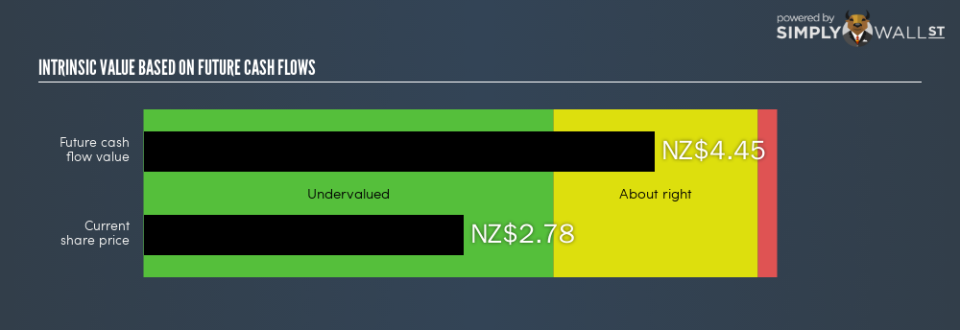Investors Are Undervaluing Air New Zealand Limited (NZSE:AIR) By 37.46%

Want to participate in a short research study? Help shape the future of investing tools and you could win a $250 gift card!
How far off is Air New Zealand Limited (NZSE:AIR) from its intrinsic value? Using the most recent financial data, I am going to take a look at whether the stock is fairly priced by projecting its future cash flows and then discounting them to today’s value. This is done using the discounted cash flows (DCF) model. It may sound complicated, but actually it is quite simple! If you want to learn more about discounted cash flow, the basis for my calcs can be read in detail in the Simply Wall St analysis model. Please also note that this article was written in February 2019 so be sure check out the updated calculation by following the link below.
View our latest analysis for Air New Zealand
The model
I use what is known as a 2-stage model, which simply means we have two different periods of varying growth rates for the company’s cash flows. Generally the first stage is higher growth, and the second stage is a more stable growth phase. In the first stage we need to estimate the cash flows to the business over the next five years. For this I used the consensus of the analysts covering the stock, as you can see below. I then discount this to its value today and sum up the total to get the present value of these cash flows.
5-year cash flow forecast
2019 | 2020 | 2021 | 2022 | 2023 | |
Levered FCF (NZ$, Millions) | NZ$-39.00 | NZ$184.00 | NZ$545.00 | NZ$563.92 | NZ$583.49 |
Source | Analyst x2 | Analyst x2 | Analyst x1 | Est @ 3.47% | Est @ 3.47% |
Present Value Discounted @ 11.52% | NZ$-34.97 | NZ$147.95 | NZ$392.94 | NZ$364.58 | NZ$338.26 |
Present Value of 5-year Cash Flow (PVCF)= NZ$1.2b
The second stage is also known as Terminal Value, this is the business’s cash flow after the first stage. The Gordon Growth formula is used to calculate Terminal Value at an annual growth rate equal to the 10-year government bond rate of 2.4%. We discount this to today’s value at a cost of equity of 11.5%.
Terminal Value (TV) = FCF2023 × (1 + g) ÷ (r – g) = NZ$583m × (1 + 2.4%) ÷ (11.5% – 2.4%) = NZ$6.5b
Present Value of Terminal Value (PVTV) = TV / (1 + r)5 = NZ$6.5b ÷ ( 1 + 11.5%)5 = NZ$3.8b
The total value, or equity value, is then the sum of the present value of the cash flows, which in this case is NZ$5.0b. The last step is to then divide the equity value by the number of shares outstanding. If the stock is an depositary receipt (represents a specified number of shares in a foreign corporation) then we use the equivalent number. This results in an intrinsic value of NZ$4.45. Compared to the current share price of NZ$2.78, the stock is quite undervalued at a 37% discount to what it is available for right now.
The assumptions
The calculation above is very dependent on two assumptions. The first is the discount rate and the other is the cash flows. You don’t have to agree with my inputs, I recommend redoing the calculations yourself and playing with them. Because we are looking at Air New Zealand as potential shareholders, the cost of equity is used as the discount rate, rather than the cost of capital (or weighed average cost of capital, WACC) which accounts for debt. In this calculation I’ve used 11.5%, which is based on a levered beta of 1.199. This is derived from the Bottom-Up Beta method based on comparable companies, with an imposed limit between 0.8 and 2.0, which is a reasonable range for a stable business.
Next Steps:
Although the valuation of a company is important, it shouldn’t be the only metric you look at when researching a company. What is the reason for the share price to differ from the intrinsic value? For AIR, I’ve compiled three relevant aspects you should further research:
Financial Health: Does AIR have a healthy balance sheet? Take a look at our free balance sheet analysis with six simple checks on key factors like leverage and risk.
Future Earnings: How does AIR’s growth rate compare to its peers and the wider market? Dig deeper into the analyst consensus number for the upcoming years by interacting with our free analyst growth expectation chart.
Other High Quality Alternatives: Are there other high quality stocks you could be holding instead of AIR? Explore our interactive list of high quality stocks to get an idea of what else is out there you may be missing!
PS. Simply Wall St does a DCF calculation for every NZ stock every 6 hours, so if you want to find the intrinsic value of any other stock just search here.
To help readers see past the short term volatility of the financial market, we aim to bring you a long-term focused research analysis purely driven by fundamental data. Note that our analysis does not factor in the latest price-sensitive company announcements.
The author is an independent contributor and at the time of publication had no position in the stocks mentioned. For errors that warrant correction please contact the editor at editorial-team@simplywallst.com.



